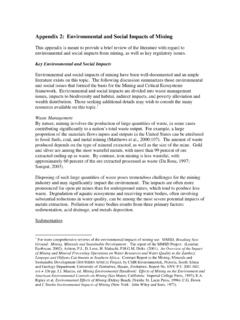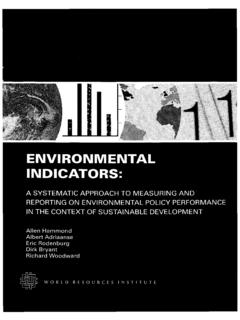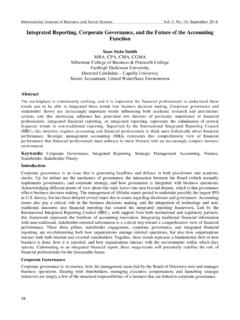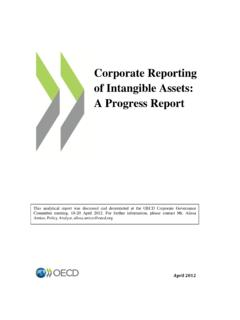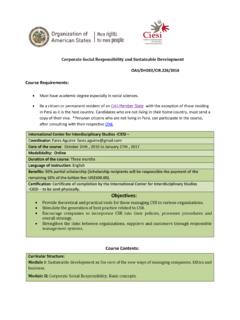Transcription of The Greenhouse Gas Protocol - World Resources Institute
1 A corporate Accounting and reporting StandardREVISED EDITIONThe Greenhouse Gas Protocol 390 370 350 330 310 290 270 ppm100015002000 Year:WORLDRESOURCESINSTITUTEWRI Cover 3/10/04 5:00 PM Page 2 GHG Protocol Initiative TeamJanet RanganathanWorld Resources Institute Laurent CorbierWorld Business Council for Sustainable Development Pankaj BhatiaWorld Resources InstituteSimon SchmitzWorld Business Council for Sustainable Development Peter GageWorld Resources InstituteKjell OrenWorld Business Council for Sustainable Development Revision Working GroupBrian Dawson & Matt SpannagleAustralian Greenhouse OfficeMike McMahonBPPierre BoileauEnvironment CanadaRob FrederickFord Motor Company Bruno VanderborghtHolcimFraser ThomsonInternational Aluminum InstituteKoichi KitamuraKansai Electric Power CompanyChi Mun Woo & Naseem PankhidaKPMGReid MinerNational Council for Air and Stream ImprovementLaurent SegalenPricewaterhouseCoopers Jasper KochShell Global Solutions International Somnath BhattacharjeeThe Energy Research InstituteCynthia CummisUS Environmental Protection AgencyClare BreidenichUNFCCCR ebecca EatonWorld Wildlife
2 FundCore AdvisorsMichael GillenwaterIndependent ExpertMelanie EddisKPMGM arie MarachePricewaterhouseCoopersRoberto AcostaUNFCCCV incent CamobrecoUS Environmental Protection AgencyElizabeth CookWorld Resources InstituteWRI Cover 3/10/04 5:00 PM Page 3261016243440485862687486889092959610310 4 Table of ContentsGUIDANCESTANDARDGUIDANCESTANDARD GUIDANCESTANDARDGUIDANCESTANDARDGUIDANCE STANDARDGUIDANCEGUIDANCEGUIDANCEGUIDANCE GUIDANCEGUIDANCEGUIDANCEGUIDANCESTANDARD I ntroductionThe Greenhouse Gas Protocol InitiativeChapter 1 GHG Accounting and reporting PrinciplesChapter 2 Business Goals and Inventory DesignChapter 3 Setting Organizational BoundariesChapter 4 Setting Operational BoundariesChapter 5 Tracking Emissions Over TimeChapter 6 Identifying and Calculating GHG EmissionsChapter 7 Managing Inventory QualityChapter 8 Accounting for GHG ReductionsChapter 9 reporting GHG EmissionsChapter 10 Verification of GHG EmissionsChapter 11 Setting GHG TargetsAppendix AAccounting for Indirect Emissions from ElectricityAppendix BAccounting for Sequestered Atmospheric CarbonAppendix COverview of GHG ProgramsAppendix DIndustry Sectors and Scopes AcronymsGlossaryReferences Contributorshe
3 Greenhouse Gas Protocol Initiative is a multi-stakeholder partnership ofbusinesses, non-governmental organizations (NGOs), governments, and othersconvened by the World Resources Institute (WRI), a environmentalNGO, and the World Business Council for Sustainable Development (WBCSD), aGeneva-based coalition of 170 international companies. Launched in 1998, theInitiative s mission is to develop internationally accepted Greenhouse gas (GHG)accounting and reporting standards for business and to promote their broad adoption. The GHG Protocol Initiative comprises two separate but linked standards: GHG Protocol corporate Accounting and reporting Standard(this document, whichprovides a step-by-step guide for companies to use in quantifying and reporting theirGHG emissions) GHG Protocol Project Quantification Standard(forthcoming; a guide for quantifyingreductions from GHG mitigation projects) 2 TIntroductionThe first edition of the GHG Protocol corporate Accounting andReporting Standard (GHG Protocol corporate Standard), published inSeptember 2001, enjoyed broad adoption and acceptance around theglobe by businesses, NGOs, and governments.
4 Many industry, NGO,and government GHG programs1used the standard as a basis fortheir accounting and reporting systems. Industry groups, such as the International Aluminum Institute , the International Councilof Forest and Paper Associations, and the WBCSD CementSustainability Initiative, partnered with the GHG Protocol Initiativeto develop complementary industry-specific calculation adoption of the standard can be attributed to the inclu-sion of many stakeholders in its development and to the fact that it is robust, practical, and builds on the experience and expertise ofnumerous experts and practitioners. This revised edition of the GHG Protocol corporate Standard is theculmination of a two-year multi-stakeholder dialogue, designed to build on experience gained from using the first edition. It includesadditional guidance, case studies, appendices, and a new chapteron setting a GHG target. For the most part, however, the first editionof the corporate Standard has stood the test of time, and thechanges in this revised edition will not affect the results of mostGHG inventories.
5 This GHG Protocol corporate Standard provides standards andguidance for companies and other types of organizations2preparing a GHG emissions inventory. It covers the accounting and reporting of the six Greenhouse gases covered by the KyotoProtocol carbon dioxide (CO2), methane (CH4), nitrous oxide(N2O), hydrofluorocarbons (HFCs), perfluorocarbons (PFCs), and sulphur hexafluoride (SF6). The standard and guidance weredesigned with the following objectives in mind: To help companies prepare a GHG inventory that represents a true and fair account of their emissions, through the use ofstandardized approaches and principles To simplify and reduce the costs of compiling a GHG inventory To provide business with information that can be used to buildan effective strategy to manage and reduce GHG emissions To provide information that facilitates participation in voluntaryand mandatory GHG programs To increase consistency and transparency in GHG accountingand reporting among various companies and GHG business and other stakeholders benefit from converging on a common standard.
6 For business, it reduces costs if their GHGinventory is capable of meeting different internal and externalinformation requirements. For others, it improves the consistency,transparency, and understandability of reported information,making it easier to track and compare progress over business value of a GHG inventoryGlobal warming and climate change have come to the fore as akey sustainable development issue. Many governments are takingsteps to reduce GHG emissions through national policies thatinclude the introduction of emissions trading programs, voluntaryprograms, carbon or energy taxes, and regulations and standardson energy efficiency and emissions. As a result, companies mustbe able to understand and manage their GHG risks if they are toensure long-term success in a competitive business environment,and to be prepared for future national or regional climate policies. A well-designed and maintained corporate GHG inventory canserve several business goals, including: Managing GHG risks and identifying reduction opportunities Public reporting and participation in voluntary GHG programs Participating in mandatory reporting programs Participating in GHG markets Recognition for early voluntary action.
7 Who should use this standard?This standard is written primarily from the perspective of a busi-ness developing a GHG inventory. However, it applies equally toother types of organizations with operations that give rise to GHGemissions, , NGOs, government agencies, and should not be used to quantify the reductions associated withGHG mitigation projects for use as offsets or credits the forthcoming GHG Protocol Project Quantification Standardwillprovide standards and guidance for this makers and architects of GHG programs can also use rele-vant parts of this standard as a basis for their own accountingand reporting to other GHG programsIt is important to distinguish between the GHG Protocol Initiativeand other GHG programs. The GHG Protocol corporate Standardfocuses only on the accounting and reporting of emissions. It doesnot require emissions information to be reported to WRI or addition, while this standard is designed to develop a verifiableinventory, it does not provide a standard for how the verificationprocess should be conducted.
8 The GHG Protocol corporate Standardhas been designed to beprogram or policy neutral. However, many existing GHG programsuse it for their own accounting and reporting requirements and itis compatible with most of them, including: Voluntary GHG reduction programs, , the World Wildlife Fund(WWF) Climate Savers, the Environmental ProtectionAgency (EPA) Climate Leaders, the Climate Neutral Network,and the Business Leaders Initiative on Climate Change (BLICC) GHG registries, , California Climate Action Registry (CCAR), World Economic Forum Global GHG Registry National industry initiatives, , New Zealand BusinessCouncil for Sustainable Development, Taiwan Business Councilfor Sustainable Development, Association des entreprises pourla r duction des gaz effet de serre (AERES) GHG trading programs, , UK Emissions Trading Scheme (UKETS), Chicago Climate Exchange (CCX), and the European UnionGreenhouse Gas Emissions Allowance Trading Scheme (EU ETS)
9 Sector-specific protocols developed by a number of industry asso-ciations, , International Aluminum Institute , InternationalCouncil of Forest and Paper Associations, International Iron andSteel Institute , the WBCSD Cement Sustainability Initiative, andthe International Petroleum Industry Environmental ConservationAssociation (IPIECA).Since GHG programs often have specific accounting and reportingrequirements, companies should always check with any relevantprograms for any additional requirements before developing their inventory. GHG calculation toolsTo complement the standard and guidance provided here, a number of cross-sector and sector-specific calculation tools are available on the GHG Protocol Initiative website ( ), including a guide for small office-basedorganizations (see chapter 6 for full list). These tools provide step-by-step guidance and electronic worksheets to help userscalculate GHG emissions from specific sources or industries.
10 Thetools are consistent with those proposed by the IntergovernmentalPanel on Climate Change (IPCC) for compilation of emissions at the national level (IPCC, 1996). They have been refined to be user-friendly for non-technical company staff and to increase theaccuracy of emissions data at a company level. Thanks to helpfrom many companies, organizations, and individual expertsthrough an intensive review of the tools, they are believed torepresent current best practice. reporting in accordance with the GHG Protocol corporate StandardThe GHG Protocol Initiative encourages the use of the GHG ProtocolCorporate Standardby all companies regardless of their experiencein preparing a GHG inventory. The term shall is used in the chapters containing standards to clarify what is required to prepareand report a GHG inventory in accordance with the GHG ProtocolCorporate is intended to improve the consistencywith which the standard is applied and the resulting informationthat is publicly reported, without departing from the initial intent ofthe first edition.
